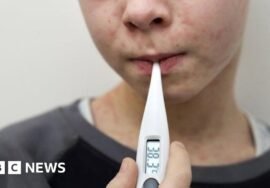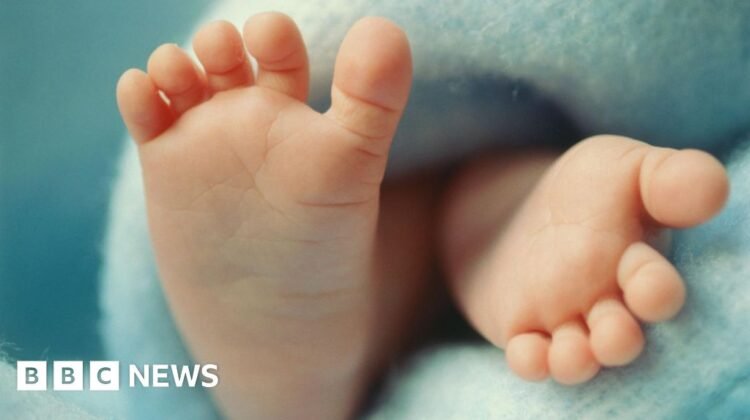
Babies from three people’s DNA prevents heriditary disease
Eight babies have been born in the UK using genetic material from three people to prevent devastating and often fatal conditions, doctors say.
The method, pioneered by UK scientists, combines the egg and sperm from a mum and dad with a second egg from a donor woman.
The technique has been legal here for a decade but we now have the first proof it is leading to children born free of incurable mitochondrial disease.
These conditions are normally passed from mother to child, starving the body of energy.
This can cause severe disability and some babies die within days of being born. Couples know they are at risk if previous children, family members or the mother has been affected.
Children born through the three-person technique inherit most of their DNA, their genetic blueprint, from their parents, but also get a tiny amount, about 0.1%, from the second woman. This is a change that is passed down the generations.
None of the families who have been through the process are speaking publicly to protect their privacy, but have issued anonymous statements through the Newcastle Fertility Centre where the procedures took place.
‘Overwhelmed with gratitude’
“After years of uncertainty this treatment gave us hope – and then it gave us our baby,” said the mother of a baby girl.
“We look at them now, full of life and possibility, and we’re overwhelmed with gratitude.”
The mother of a baby boy added: “Thanks to this incredible advancement and the support we received, our little family is complete.
“The emotional burden of mitochondrial disease has been lifted, and in its place is hope, joy, and deep gratitude.”
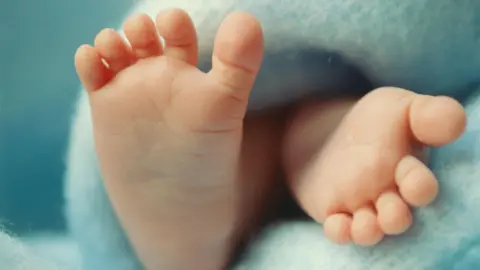 Getty Images
Getty ImagesMitochondria are tiny structures inside nearly every one of our cells. They are the reason we breathe as they use oxygen to convert food into the form of energy our bodies use as fuel.
Defective mitochondria can leave the body with insufficient energy to keep the heart beating as well as causing brain damage, seizures, blindness, muscle weakness and organ failure.
About one in 5,000 babies are born with mitochondrial disease. The team in Newcastle anticipate there is demand for 20 to 30 babies born through the three-person method each year.
Some parents have faced the agony of having multiple children die from these diseases.
Mitochondria are passed down only from mother to child. So this pioneering fertility technique uses both parents and a woman who donates her healthy mitochondria.
The science was developed more than a decade ago at Newcastle University and the Newcastle upon Tyne Hospitals NHS Foundation Trust and a specialist service opened within the NHS in 2017.
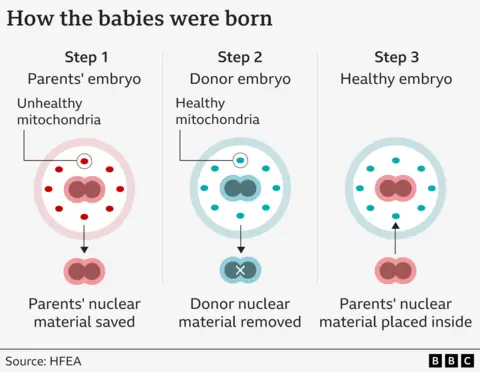
The eggs from both the mother and the donor are fertilised in the lab with the dad’s sperm.
The embryos develop until the DNA from the sperm and egg form a pair of structures called the pro-nuclei. These contain the blueprints for building the human body, such as hair colour and height.
The pro-nuclei are removed from both embryos and the parents’ DNA is put inside the embryo packed with healthy mitochondria.
The resulting child is genetically related to their parents, but should be free from mitochondrial disease.
A pair of reports, in the New England Journal of Medicine, showed 22 families have gone through the process at the Newcastle Fertility Centre.
It led to four boys and four girls, including one pair of twins, and one ongoing pregnancy.
“To see the relief and joy in the faces of the parents of these babies after such a long wait and fear of consequences, it’s brilliant to be able to see these babies alive, thriving and developing normally,” Prof Bobby McFarland, the director of the NHS Highly Specialised Service for Rare Mitochondrial Disorders told the BBC.
All of the babies were born free of mitochondrial disease and met their expected developmental milestones.
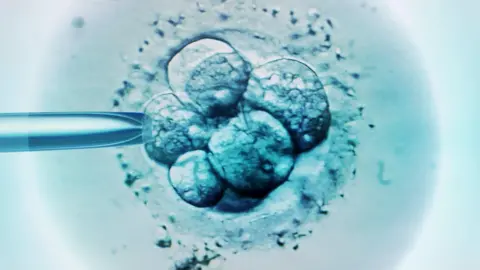 Getty Images
Getty ImagesThere was a case of epilepsy, which cleared up by itself and one child has an abnormal heart rhythm which is being successfully treated.
These are not though to be connected to defective mitochondria. It is not known whether this is part of the known risks of IVF, something specific to the three-person method or something that has been detected only because the health of all babies born through this technique is monitored intensely.
Another key question hanging over the approach has been whether defective mitochondria would be transferred into the healthy embryo and what the consequences could be.
The results show that in five cases the diseased mitochondria were undetectable. In the other three, between 5% and 20% of mitochondria were defective in blood and urine samples.
This is below the 80% level thought to cause disease. It will take further work to understand why this occurred and if it can be prevented.
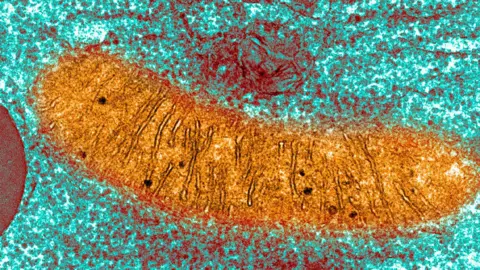 Getty Images
Getty ImagesProf Mary Herbert, from Newcastle University and Monash University, said: “The findings give grounds for optimism. However, research to better understand the limitations of mitochondrial donation technologies, will be essential to further improve treatment outcomes.”
The breakthrough gives hope to the Kitto family.
Kat’s youngest daughter Poppy, 14, has the disease. Her eldest Lily, 16, may pass it onto her children.
Poppy is in a wheelchair, is non-verbal and is fed through a tube.
“It’s impacted a huge part of her life,” says Kat, “we have a lovely time as she is, but there are the moments where you realize how devastating mitochondrial disease is”.
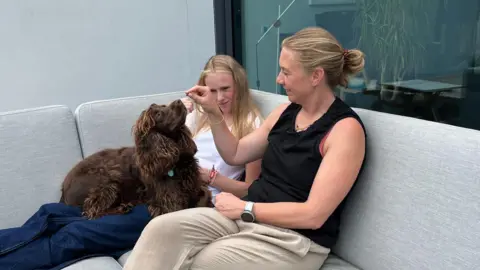 BBC/Josh Elgin
BBC/Josh ElginDespite decades of work there is still no cure for mitochondrial disease, but the chance to preventing it being passed on gives hope to Lily.
“It’s the future generations like myself, or my children, or my cousins, who can have that outlook of a normal life,” she says.
‘Only the UK could do this’
The UK not only developed the science of three-person babies, but it also became the first country in the world to introduce laws to allow their creation after a vote in Parliament in 2015.
There was controversy as mitochondria have DNA of their own, which controls how they function.
It means the children have inherited DNA from their parents and around 0.1% from the donor woman.
Any girls born through this technique would pass this onto their own children, so it is a permanent alteration of human genetic inheritance.
This was a step too far for some when the technology was debated, raising fears it would open the doors to genetically-modified “designer” babies.
Prof Sir Doug Turnball, from Newcastle University, told me: “I think this is the only place in the world this could have happened, there’s been first class science to get us to where we are, there been legislation to allow it to move into clinical treatment, the NHS to help support it and now we’ve got eight children that seem to free of mitochondrial disease, what a wonderful result.”
Liz Curtis, the founder of the Lily Foundation charity said: “After years of waiting, we now know that eight babies have been born using this technique, all showing no signs of mito.
“For many affected families, it’s the first real hope of breaking the cycle of this inherited condition.”



